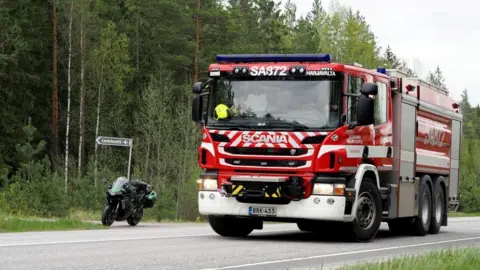In a tragic incident that has sent shockwaves through the aviation community and the general public, two helicopters collided mid-air near Eura, Finland. The collision occurred around noon local time on May 17, 2025, shortly after the civilian helicopters departed from Tallinn, the capital of Estonia. While the exact number of fatalities has yet to be confirmed by local authorities, there were five individuals aboard both helicopters—two in one helicopter and three in the other.
The purpose of the helicopters’ flight was to attend an aviation event at the Piikajärvi Flight Center located in Kokemäki. This gathering of aviation enthusiasts typically attracts participants keen on aviation displays and activities, and it is disheartening that such a tragedy interrupted what was meant to be a day of celebration and camaraderie among aviation lovers.
The collision occurred in close proximity to Eura Airport, raising questions about the circumstances leading up to the crash. Eyewitness accounts, albeit limited at this early stage of the investigation, indicate that both helicopters were flying in tandem when the tragic accident happened. As the police and local authorities conduct investigations, they are expected to analyze flight data, witness testimonies, and other relevant information to determine the cause of this unfortunate incident.
Among the fatalities, the identity of the victims has yet to be disclosed pending notification of their next of kin. The local community has rallied together, expressing shock and sorrow over the incident. Memorial services and tributes are anticipated to honor the lives lost in this tragedy.
Aerial collisions, while rare, can happen for various reasons, including miscommunication between pilots, adverse weather conditions, or failure to adhere to air traffic regulations. As authorities delve into the investigation, a focus will be placed on these aspects and whether appropriate safety measures and protocols were in place on the day of the incident.
Following the accident, the safety of helicopter flights, especially those chartered for events and public gatherings, will likely come under scrutiny. Aviation experts and regulatory bodies will evaluate current safety practices to identify areas for improvement, ensuring that similar incidents do not occur in the future.
The collision site included areas near woodland, filled with emergency vehicles as first responders rushed to the scene to provide help and assistance. Video footage and images of the emergency response showed personnel working diligently to manage the situation, emphasizing the seriousness of accidents that involve aerial vehicles.
In the wake of this disaster, local media coverage has included both news updates and community reactions. Public sentiment leans towards supporting the victims’ families, with various initiatives potentially emerging to assist those affected. The aviation community, too, is likely to share insights on improving safety protocols during events that involve multiple aircrafts operating in close proximity.
As investigations continue, both Finnish authorities and the local community are left to grapple with the consequences of this tragic event. The loss of life serves as a sobering reminder of the risks associated with aviation, underscoring the importance of stringent safety measures in ensuring the wellbeing of all those participating in aerial activities.
As more information surfaces about the victims, the cause of the collision, and any recommendations for future safety regulations, this incident may have lasting implications for aviation practices in Finland and beyond. The hope is that through thorough investigation and reflection, the aviation industry can learn and adapt to prevent such heart-wrenching tragedies from occurring in the future.



